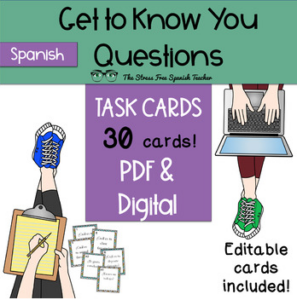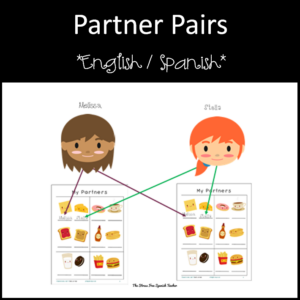The First Week of Spanish Class, Part 1
The First Week of Spanish Class!


This is Part 1 in a 5 part series of blog posts discussing ideas of how to set up your Spanish classes for the first week of class in ways that will can help create an environment conducive to language acquisition. I hope you find some of the information useful! I would also love to hear your suggestions because the more we share the better teachers we become! Please consider leaving a comment with your suggestions at the end of this post!
According to The Danielson Group, as teachers we have 5 major tasks to consider when creating our Classroom Environment.
2a Creating an Environment of Respect and Rapport
2b Establishing a Culture for Learning
2c Managing Classroom Procedures
2d Managing Student Behavior
2e Organizing Physical Space
Please see my suggestions for each of these Domain components. This is part 1 of a 5 part series in which I will discuss the framework 2A.
2a Creating an Environment of Respect and Rapport:
- One way to show your students respect is to greet them at the door. And as you get to know your students’ names, greet them by name as well. This can lead to a classroom routine in which your students know they will be responsible for having a conversation with you in the Target Language on a daily basis, even if it is just a short “Buenos días Señor, ¿Cómo está Ud.?”
- Students want to know that you genuinely care about them. Get to know them, their likes & dislikes, if they participate in any extra-curricular activities, do they come from big or small families? One way to facilitate this is for students to create “About Me” banners during the first week of school. Please find my FREE “Todo Sobre Mi” banner HERE:

- Your classroom should be a safe place to make mistakes and risk failure. Let students know that they will make mistakes and that they should be making mistakes! Use your own mistakes as examples to assure students that they will say things wrong and the world won’t end. Pull out some of your anecdotal evidence and let your students know that you’re only human. When a student makes a particular wonderful mistake, use it as an example! You can even say, “Thank you for making that mistake!” or even “I was hoping someone would make that mistake! And here’s why!”
- Make sure your students know that they can ask you questions. This may seem obvious to you, but some students need to actually hear it.
- Students should also be respectful of one another in the classroom. Praise good behavior and make it clear this is what you expect from them. Before students present to the class, remind everyone of what you expect of them before, during and after each student has presented. “What does a good listener look like? What does a good audience look like? Sound like? Act like?”
- Help your students get to know one another. Don’t assume that because you are teaching a high school Spanish class that all of your students grew up together and know one another.–Have students interview one another in order to both practice the language and to get to know one another.Try this set of Get To Know You Task Cards or Interview Questions, or a Task Cards Set of Would You Rather Questions.


I sincerely hope that this list has given you some new ideas to work with in your Spanish classes!
Gracias y Buena Suerte!


